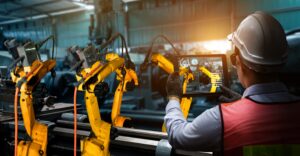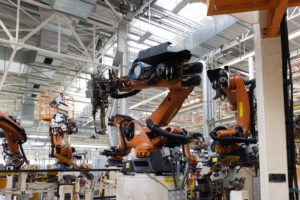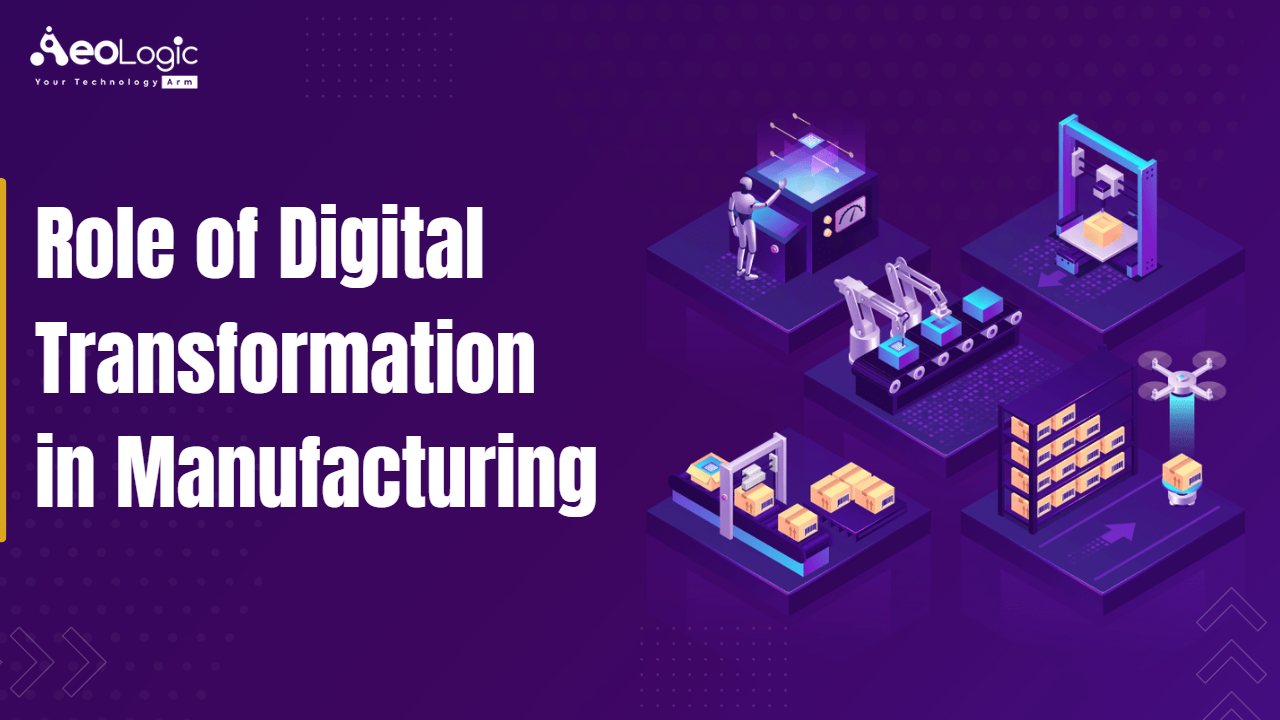The role of digital transformation in manufacturing is rapidly evolving in the entire industry. If CIOs of manufacturing companies are not understanding what’s best for their business and customers now and in the future, then they’ll be left struggling with revenue, unproductive people, legacy software, obsolete equipment, and outdated processes.
Therefore, to prepare for the future and stay relevant in their industry, manufacturing companies must invest in digital potential, software, and technologies. In order to gain an edge in an already hypercompetitive market.
Also read: The Importance of Digital Transformation for the Industry
What is the Role of Digital Transformation in Manufacturing?
The role of digital transformation in manufacturing is when an organization is implementing new digital technologies for improving all aspects of the manufacturing process. Furthermore, this can be a wholesale approach or a piece-by-piece implementation where software applications and digitization is the important driver.
Role of Digital Transformation in Manufacturing
The impact of digital transformation in the manufacturing industry is comprehensive and includes developments in standards, safety, quality, throughput, efficiency, revenue, and sustainability. All while mitigating costs to stay competitive in the marketplace. The roles are vast, and this transformation must occur for keeping up with evolving customer demands and stiff competitors.
Here are a few major advantages of digital transformation for manufacturing companies:
- When you offer digital solutions that enhance your safety, fewer workplace injuries and accidents occur
- While improving your output quality, you are decreasing the rework of products, reducing warranty work, and boosting customer satisfaction
- When you increase your process efficiency positively influences employee productivity and your bottom line. A robust bottom line enables you to continue to innovate and drive sustainability in your market. All while boosting value for your company, shareholders, and customers.
Furthermore, digital transformation is also leading to real-time manufacturing data. These digital processes are allowing you to capture data instantaneously, corresponding to analysis for faster real-time decisions by the company. It’s not only for reactive responses but also for predictive analytics to create better future processes and products. Hence, this normalizes preventative maintenance and failure approaches that are directly impacting all aspects of the business.
Digital transformation in manufacturing derives empowerment. Empowerment for having a voice and doing something about improving a process, holding yourself and others accountable to do better. And also having a constantly improving mindset in the business. Empowerment comes in several ways. However, it is most powerful when aligned with the future vision of the organization and effective communication with the workforce.
Examples of Manufacturing Digitalization in 2023
As all organizations and manufacturing processes are different and personalized, so are examples of what could be implemented and how it can be executed. Therefore, to help get manufacturing CIOs, CTOs, and other leaders started with digital transformation in the manufacturing sector. Here are a few examples of manufacturing digitalization:
1. Industrial IoT Sensors
These devices help in measuring and monitoring industrial processes. They can be deployed in the field, in manufacturing plants, or even at other locations. Where there is a need to gather data about the performance of different equipment. It includes gas sensors that help in measuring the amount of oxygen in a particular zone. Also, temperature sensors will help in monitoring the temperature of an object or process, and pressure sensors measure deviations in air pressure around a device.

The most common applications for industrial Internet of Things (IoT) sensors are as follows:
- Monitoring equipment and plant operations
- Checking energy consumption
- Inventory management
- Monitoring equipment maintenance
- Measuring environmental conditions like pressure, humidity, or temperature
2. Big Data and Analytics
Big data is referring to the increasing volume, velocity, and variety of data companies generate and collect. It is now an important part of business operations because it facilitates in measuring performance and improving overall efficiency.

The incorporation of big data is allowing manufacturers to identify trends in their business and take action on them. They help in making informed decisions about product development, supply chain management, and other major aspects of running a manufacturing business.
3. AI, Automation, and Machine Learning
AI-powered digital transformation is changing manufacturing companies into smarter, streamlined, safer companies. One of the most exciting facts about artificial intelligence (AI), automation, and machine learning is that they can build manufacturing companies more efficient by automating various tedious and monotonous processes for workers. Also, they empower manufacturers to better predict trends and enhance quality control. Hence, making products faster and reducing waste. Furthermore, manufacturing companies are already using these technologies in different ways. For instance, one company may use AI technology for analyzing data from its customers’ orders for making sure that they’re getting what they want when they order something from them. Another company may utilize machine learning for finding patterns in its customers’ data to predict what products they’ll be interested in purchasing next time.
4. Cloud-Based ERP and Other Manufacturing Software
Another role of digital transformation in manufacturing is cloud-based enterprise resource planning (ERP) systems and other manufacturing software. These applications are providing tools for managing business operations. A cloud-based ERP system can help you in storing your company’s data in the cloud. Hence, allowing you to access it anywhere. Furthermore, implementing a new ERP makes it smoother for employees to collaborate on projects or access information when they’re not in their offices. You can even use cloud-based ERP software for managing your inventory, production, customer relationships, and so on.
Manufacturers are gradually turning to cloud-based ERP systems for streamlining their operations. These systems are enabling manufacturers to access the same tools they use in their offices. Therefore, allowing them to spend less time on paperwork and more time on what they do best: creating products.
With these new platforms, manufacturers are able to track their inventory in real-time, so they never have to worry about running out of inventory. They also make it simpler for manufacturers to communicate with customers and partners, which implies more sales and fewer headaches for everyone involved.
5. Smart Manufacturing
Smart manufacturing is used to describe the incorporation of digital technology and automation for communicating with other devices or systems and gathering data about the system’s operation.
Furthermore, smart manufacturing can be applied to all features of manufacturing, including production management, supply chain management, and quality control.
The goal of smart manufacturing is to take leverage of new technologies to make processes more productive and efficient.

The major benefits of smart manufacturing include:
- Improving quality control and production scheduling
- Improving inventory planning
- Quick problem resolution
- Reducing overall costs
6. 3D Printing
3D printing is considered to be one of the most transformative manufacturing technologies in recent years, and other sectors are already using it to innovate new products.
Also, 3D printing is a process that helps in creating objects from digital data. It uses lasers for laying down layers of material, which harden to create the object. The technology can be used to construct entire objects or the parts that make them up.
Also read: Benefits of Digital Transformation for your Business
7. Predictive Maintenance
Digital transformation in manufacturing is making use of predictive maintenance. Predictive maintenance is helping manufacturers in monitoring equipment and machinery for signs of wear. It can also help in predicting when parts require to be replaced or if something needs to be fixed before it breaks down.
Predictive maintenance systems are utilized by several industries, including automotive, pharmaceuticals, oil and gas, building construction and maintenance, and more.
Predictive maintenance systems are constantly monitoring the health of your equipment and making adjustments as needed. This is implying that even while you’re not looking at your equipment, it’s already operating to keep it running at its best.
This type of system also has the added advantage of helping save money on repairs and maintenance costs. Since it is allowing you to avoid problems before they happen.
8. Augmented and Virtual Reality
Augmented and virtual reality are two technologies often used interchangeably; however, they are quite different.
- Augmented reality is when a user’s surroundings are improved by computer-generated information.
- Virtual reality is when the user is entirely immersed in a digital environment.
In the manufacturing industry, both technologies have been implemented to facilitate businesses in improving their processes and increasing efficiency.
Digital Transformation Challenges in Manufacturing
The role of digital transformation in manufacturing is evolving, and every evolution has its challenges. Today, manufacturers need to keep up with the rapid pace of transformation while also making sure they facilitate business growth.
The following sections will be highlighting major digital transformation challenges manufacturers must overcome when implementing new digital technologies and strategies.
The Initial Investment Capital
Medium to small-sized organizations may not have the budgets to invest in new technologies. This can be An obstacle when organizations intend to move toward the era of digitalization. However, manufacturers must learn to observe the bigger picture. Undoubtedly, there will be upfront investment costs, but think about what the cost of not investing in digital technology and keeping up with the global movement will be. A good investment strategy is needed to help manufacturers know; how much to keep aside and when; what improvements and changes to make, and how to measure their outcomes.
Lack Of Knowledge And Experience About Digital Transformation
The role of digital transformation in manufacturing is huge. One of the biggest manufacturing digitization challenges is the lack of required knowledge in implementing advanced manufacturing technologies in a safe and secure approach. When augmenting their advanced technology capabilities in manufacturing, it’s needed that manufacturers have to make an effort to learn to use advanced data analytics, digital twins, AI and machine learning, and automation. Otherwise, the lack of knowledge in these, and other verticals, can hold back development. Furthermore, manufacturing companies may not have their own tech teams for answering all their questions or suggesting the most suitable operational plans. So, outsourcing can be useful to reduce the stress of adoption.
Rigid Infrastructure
For starting a digital transformation in manufacturing, manufacturers’ efforts need to be used to overcome existing infrastructures which are rigid. And probably incompatible with advanced technology potential. Digital transformation in manufacturing is requiring the organization to transform in every aspect, beginning with the training. Training may include the following:
- Advanced robotic operations
- Flexible production line arrangements
- Cloud-based resource planning
Also read: Biggest Challenges to a Successful Digital Transformation
Conclusion
The role of digital transformation in manufacturing is wholesale. Subsequently, it is including improvements in safety, quality, throughput, efficiency, revenue, and sustainability. All while mitigating costs to stay competitive in the marketplace. The impacts are vast, and this transformation must occur to keep up with evolving customer demands and stiff competitors. Therefore, developing a platform ecosystem that is responding to requirements, rather than responding to existing software. It is needed to overcome conventional challenges. Hence, migrating to cloud-based digital manufacturing, and capturing the several advantages that are available.
Contact us for digital transformation adoption!
FAQs
What is the role of digital transformation in manufacturing?
Digital transformation in manufacturing calls for a mix of emerging technologies that solve age-old industrial objectives: boost production, enhance quality and decrease equipment downtime.
How is digitization transforming the manufacturing industry?
In a manufacturing organization, digitization can include any operation including the back office and factory automation, supply chain applications, data analytics, and more. Digital evolution is having the potential to disrupt every part of the enterprise.









